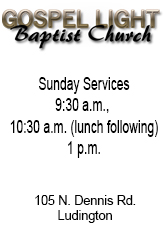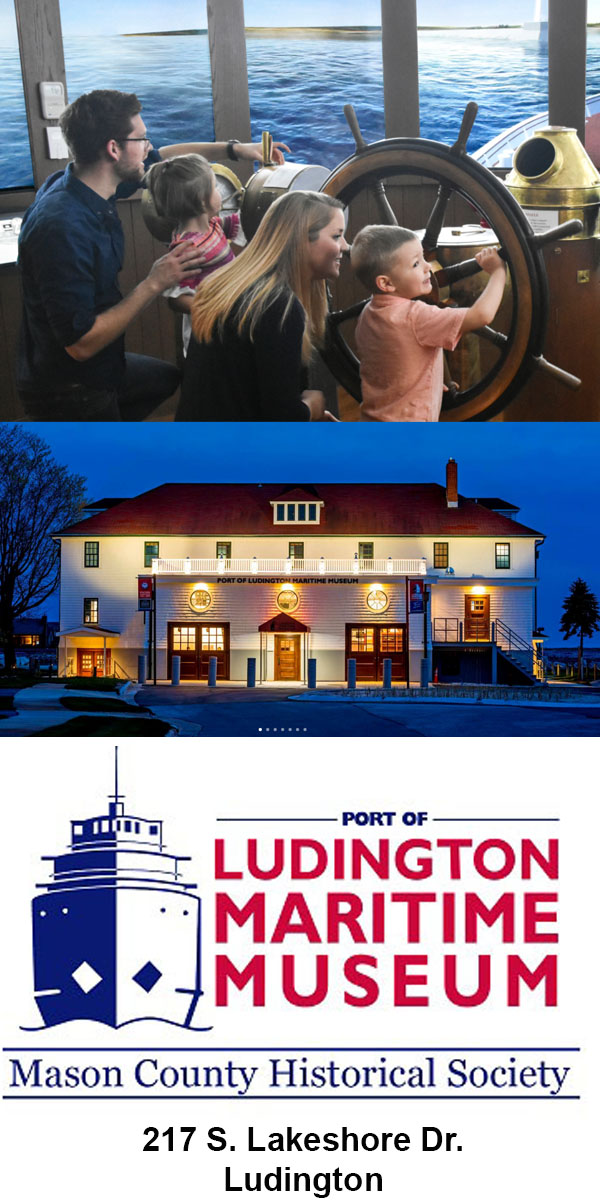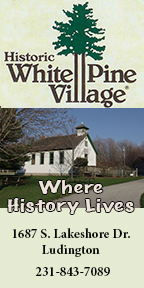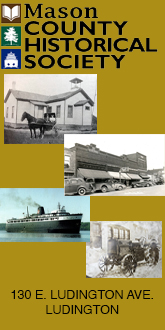 MC History Spotlight: Burr Caswell, first permanent settler.
MC History Spotlight: Burr Caswell, first permanent settler.
MC History Spotlight is a weekly history column brought to you by Ludington Woods Living and Memory Care. Each week this column features a story from our county’s past.
By Rob Alway, Editor-in-Chief.
Burr Caswell was one of Mason County’s first permanent non-native settlers. Many people who live or visit Mason County and who have visited Historic White Pine Village are familiar with Caswell’s home, which served as the county’s first courthouse.
Burr Caswell was born in January 1807 in Glens Falls, NY, the same month as Robert E. Lee. Thomas Jefferson was serving as the third president of the United States.
A month after Caswell was born, former Vice President Aaron Burr was arrested on charges of treason, accused of plotting to annex parts of Louisiana and Mexico to become part of an independent republic. He was acquitted later that year.
In 1837, Caswell married Hannah Green in Glens Falls. They eventually moved to the lower Mississippi River area and then to Lake County, Illinois, where they lived for six years, according to The History of Manistee, Mason, and Oceana, published in the late 1800s.
In 1845, Caswell came to the area that was known as Pere Marquette (Ludington) and spent two seasons there, mostly fishing. He spent a winter in Pentwater and then in July 1847 he returned with his family, which at the time consisted of himself, Hannah, and four children, Helen, Mary, George and Edgar.
In her 1968 book “The Old House Remembers,” local historian Rose Hawley recounted that Caswell had been interested in lumbering in the area.

The house as it appeared before restoration.
“It had been his intention to settle farther north along the shore at Manistee, but something prompted him to investigate the area along here,” she wrote. “And anchoring their ship on the third sand bar, the family came to land in a yawl. And once viewing the scene, Manistee was forgotten; and making do in a small cabin for the period of building.”
The Caswells built their house out of driftwood (most likely wood that was released from sawmills, which might have had a minor flaw, or from overloaded lumber schooners, which had been wrecked during storms on the lake). It was located near an Ottawa Indian village.
“He improved his farm as rapidly as possible and worked some at lumbering,” the Manistee, Mason, Oceana book states. “The Indians at once took a liking to him and were always his friends, ever ready to do him any favor or act of kindness.
Other settlers came before the Caswells. The Manistee, Mason, Oceana book states that William Quivillon, who was working for Louis Campeau and Sen. William T. Ferry, came to the area in 1835 to trade with Indians. Quivillon left the area but returned with his family in 1850 and established a farm on the property that is now Summit Park in Summit Township, according to “The Old House Remembers”.

2019 photograph of house
The book also states: “In June, 1840, Joseph L. Wheeler entered a portion of the lake fronts, on Pere Marquette Lake, and in 1844 John H. Harris entered 37 acres at what is now called Free Soil Mills”, which was established in 1845-1846 and was located near the mouth of Gurney Creek in Section 6 of what is now Grant Township; originally Free Soil Township included what is now Grant, Free Soil, and Meade townships. The mill burned shortly afterwards and was rebuilt in 1855 by Freeman and Hopkins who employed S.K. Hutchinson to help build it. “When Mr. Hutchinson came there in 1855, there were but two persons living in that vicinity, a white man named Hopkins and a negro (term used in book) woman, who had been his father’s slave in Missouri.”
In 1847, Charles Mears also built a mill at Black Creek, later known as Lincoln (near modern day Lincoln Hills Golf Club in Hamlin Township). “A log house and blacksmith shop were first built.”
In 1847, Joseph Boyden acquired 72 acres fronting on Pere Marquette Lake,
In 1849, Thomas Secor acquired 40 acres at Free Soil Mills. That same year, Baird and Bean built a mill at Pere Marquette which later was purchased by James Ludington. “The building of this mill was the beginning of business at Pere Marquette.”

Painting of house in its original state
The Caswells, though, were recorded as the first known family to settle in the area and the home they built in 1849 was the first frame house. In 1855, when Mason County officially became a county and separated from Ottawa County, Burr offered the first floor of the house for county use. The first floor was then used as a courthouse while the family moved upstairs. In the back of the main floor was a trading post while the basement was used as the county’s first jail.
Caswell served as county supervisor, justice of the peace and probate judge.
In 1861, when the county’s seat of government was moved to Lincoln village, the house reverted back to a single family residence.
Caswell remained on his farm until the death of his wife, February 1870, when he moved to Ludington, where he was in charge of a shingle mill. Caswell married again in 1871, to Sarah Billings, and in 1873 he was placed in charge of Big Sable Point Lighthouse.
He sold the house in 1870 to Adam Patterson and his wife (name not mentioned in historical books). The Pattersons raised 10 children in the house. After their death, the house was left vacant.
According to the Mason County Historical Society, Jerome Jorissen, co-founder of White Pine Village, acquired the land on which the house stood and with help, restored it to begin the “dream” of Pioneer Village in the 1960s, which opened in the mid-70s. The village was eventually renamed White Pine Village.
Ludington Woods Assisted Living and Memory Care, 502 N. Sherman St., Ludington, MI 49431; 231-845-6100; www.ludingtonwoods.com.
This story is copyrighted © 2019, all rights reserved by Media Group 31, LLC, PO Box 21, Scottville, MI 49454. No portion of this story or images may be reproduced in any way, including print or broadcast, without expressed written consent.






























 (1).gif)
















.png)














